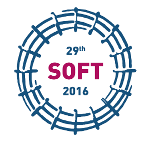Speaker
Teruya Tanaka
(National Institute for Fusion Science)
Description
In our previous study, a Cr2O3 layer was formed on a reduced activation ferritic/martenstic (RAFM) steel substrates by heat treatment under a reduced atmosphere and it could suppress hydrogen permeation by ~2 orders at 550-650 ooC. Since the Cr2O3 layer was stable at high temperatures in air, it was also a preferable underlayer for multi-layer ceramic coating with the metal organic decomposition method. In the present study, formation of Cr2O3 layers on candidate duct materials for liquid blanket systems, i.e. HASTELLOY X, INCONEL 600 and SUS316L, are examined.
The substrates were heat treated in a vacuum of 5 Pa at 700 ooC for 1 hour. During the heating up and cooling down processes, the pressure was kept at <5x10-3-3 Pa to suppress formation of Fe2O3 which degrades permeation barrier performances. On the HASTELLOY substrate, a ~150 nm thick Cr2O3 layer was formed. The thickness and the blue-colored surface were similar to those previously obtained on RAFM steel substrates. On the INCONEL substrate, a thinner Cr2O3 layer of ~50 nm was obtained. These Cr2O3 layers on the Ni-based alloys are expected to suppress hydrogen permeation and to be stable underlayers in multi-layer ceramic coating fabrication. However, a thick Fe2O3 layer of >200 nm was formed on a SUS316L substrate. Although the composition of the surface layer was improved to 60 at% Fe2O3 and 40 at% Cr2O3 by treatment at 800 ooC, further improvement of the condition will be required to suppress the Fe2O3 production. Characterization of the Cr2O3 layers including hydrogen permeation barrier performances is being performed at present.
Co-authors
Akio Sagara
(National Institute for Fusion Science, 322-6 Oroshi-cho, Toki, Gifu, Japan)
Junki Morimoto
(The Graduate University for Advanced Studies, 322-6 Oroshi-cho,Toki, Gofu, Japan)
Takeo Muroga
(National Institute for Fusion Science, 322-6 Oroshi-cho, Toki, Gifu, Japan)
Takumi Chikada
(Shizuoka University, 836 Ohya, Suruga-ku, Shizuoka, Japan)
Teruya Tanaka
(National Institute for Fusion Science, 322-6 Oroshi-cho, Toki, Gifu, Japan)
Yoshimitsu Hishinuma
(National Institute for Fusion Science, 322-6 Oroshi-cho, Toki, Gifu, Japan)

